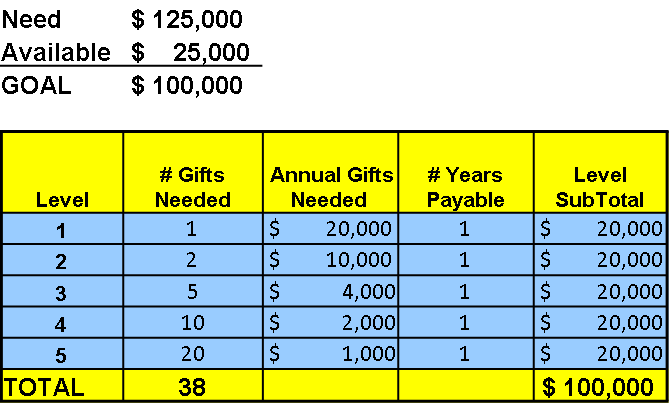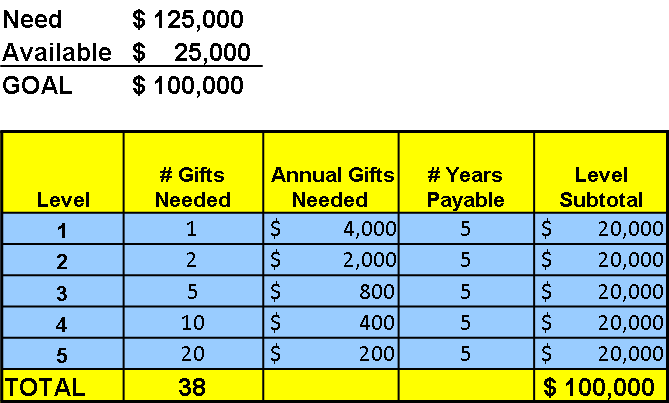In the first article of this series, we set a fundraising goal of $100,000 using a Major Gifts Table (personal visit) strategy for our hypothetical nonprofit. Step two is recognizing that in addition to money, your time is also in limited supply. You can only call, cultivate and meet with a limited number of prospective donors in a day, week or year. The number you need to know in creating a Major Gifts Table is 38, which is the maximum number of donations you will need to plan for to be successful.
The fundraising goal and number of donations can now be used together to create a Major Gifts Table. The Major Gifts Table is a tiered list that illustrates the necessary value and volume of gifts required to successfully achieve the fundraising goal. It also frames the maximum and minimum fundraising donations that you will have to ask for.
There are two important things to note regarding the size of donations you are seeking. First, that the true maximum donation is 100% of the goal. If a single donor will fund the entire project, do it. Do not get locked into the top limit of the gift table! Second and conversely, the minimum donation is an absolute minimum. You should never spend time meeting for gifts below this amount! Every gift below the minimum means you’ll need extra gifts, extra visits and that means you’ll be adding to your workload. You just won’t have time to complete enough visits to reach the goal. Getting larger gifts reduces the number of gifts/visits, you’ll need making your workload and goal attainment easier.
Example Major Gift Table 1: For our sample nonprofit a major gift table for a $100,000 fundraising goal from 38 donations looks like this:

Example Major Gift Table 2: If the size of gifts seems too large for your organization, consider spreading the goal out over time. Expanding the timeline to a five year goal would make the Major Gifts Table look like this:

The Major Gifts Table can have any number of levels, but to keep it simple with a manageable workload, it’s best to use five or fewer levels.
Notice the minimum gift size is example table 1 and 2 is $1,000 and $200 respectively. These are your “do not leave the office” numbers. If you aren’t meeting with a donor having the potential to give this amount stay in the office and book new meetings or find new prospects!
Knowing that 38 donations are required, a fundraiser can meet and ask prospective donors for a gift from each level of the Major Gifts Table. Starting at the top, work your way down the table from the maximum to the minimum donation level, and ask your highest to lowest ranked prospects for their donation respectively. This top-down process is important as the early donations will set the standard and influence those that follow to give more generously.
In addition to a planning tool, the Major Gifts Table also serves as an excellent presentation tool. It’s something you can show to a potential donor demonstrating your organization’s fundraising strategy. And helps the potential donors establish a framework for what is a necessary range for their own gift.
The Major Gifts Table can also help the fundraiser make “The Ask” for a donation. The fundraiser can use the table in three ways: To ask directly by amount or specific giving level; To ask for an amount within a range of amounts or giving levels; Or if you’re nervous about asking for money, you can present the table and ask where do you see yourself fitting into this picture?
The Major Gifts Table is a valuable planning, presentation and solicitation tool. Every fundraiser needs one before starting a fundraising effort. Don’t leave the office without one!
In the next article in this series we’ll look at how many prospects you’ll need and how to find the best donors for your organization. You may also want to read the “Developing Your List” article series to learn where to find prospects.
In the remaining articles in this series we’ll look at developing and using:
- Major Gift Tables
- Prospect Lists
- Volunteer Teams
- Case Statements
- Fundraising Budget


